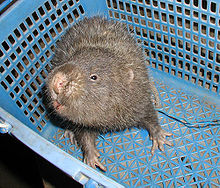
Rattus is a genus of muroid rodents, all typically called rats. However, the term rat can also be applied to rodent species outside of this genus.

Talaromyces marneffei, formerly called Penicillium marneffei, was identified in 1956. The organism is endemic to southeast Asia where it is an important cause of opportunistic infections in those with HIV/AIDS-related immunodeficiency. Incidence of T. marneffei infections has increased due to a rise in HIV infection rates in the region.

The rodent subfamily Rhizomyinae includes the Asian bamboo rats and certain of the African mole-rats. The subfamily is grouped with the Spalacinae and the Myospalacinae into a family of fossorial muroid rodents basal to the other Muroidea.
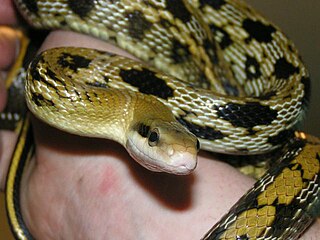
The beauty rat snake, also called the beauty ratsnake, the beauty snake, or the cave racer, is a species of snake in the family Colubridae. The species is native to the eastern and southeastern regions of Asia. It is a long, thin, semi-arboreal species of snake with several recognized subspecies. This constrictor feeds on rodents, and though it is favored in some locations as a natural pest control or pet, it is also considered an invasive species in other locations.
The Giant Rat of Sumatra is a fictional giant rat, first mentioned by Arthur Conan Doyle in "The Adventure of the Sussex Vampire". As part of the tale, the protagonist, Sherlock Holmes, declares that there is a "story" connected with this rat, presumably a detective case he has handled. The name of the rat and its implied unpublished history were later used in works by many other writers.

The white-rumped shama is a small passerine bird of the family Muscicapidae. Native to densely vegetated habitats in the Indian subcontinent and Southeast Asia, its popularity as a cage-bird and songster has led to it being introduced elsewhere.

The large Indian civet is a viverrid native to South and Southeast Asia. It is listed as Least Concern on the IUCN Red List. The global population is considered decreasing mainly because of trapping-driven declines in heavily hunted and fragmented areas, notably in China, and the heavy trade as wild meat.

The moonrat is a southeast Asian species of mammal in the family Erinaceidae. It is the only species in the genus Echinosorex. The moonrat is a fairly small, primarily carnivorous animal which, despite its name, is not closely related to rats or other rodents. The scientific name is sometimes given as Echinosorex gymnurus, but this is incorrect.
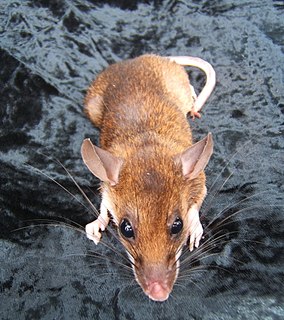
Maxomys is a genus of rodents, widespread in Southeast Asia. They are mid-sized rodents, similar to rats, that live on the ground of tropical rainforests. There they build nests, padded with fallen leaves from trees. They feed on roots, fallen fruit, and other plants, as well as insects. All species are shy and avoid food from humans.

The greater bandicoot rat is a species of rodent in the family Muridae found in Bangladesh, China, India, Indonesia, Laos, Malaysia, Myanmar, Nepal, Sri Lanka, Taiwan, Thailand, and Vietnam. It can grow to about 27–29 cm without including the tail which can grow to 28 cm. These should not be confused with marsupial bandicoots which inhabit Australia and neighbouring New Guinea, which were named after the bandicota rats.

The lesser racket-tailed drongo is a species of bird in the family Dicruridae. It is found in the Indian Subcontinent and Southeast Asia.

The red-headed trogon is a species of bird in the family Trogonidae.
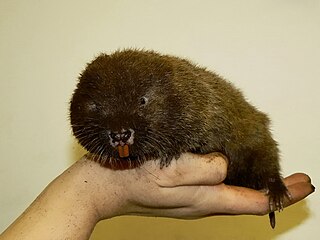
The lesser bamboo rat is a species of rodent in the family Spalacidae. It is monotypic within the genus Cannomys. It is found in Bangladesh, Bhutan, Cambodia, China, India, Myanmar, Nepal, and Thailand.

The spotted giant flying squirrel, also known as the lesser giant flying squirrel, is a species of rodent in the family Sciuridae. It is found in hill and mountain forests at altitudes of 200–4,000 m (660–13,120 ft) in Southeast Asia north to central China and the east Himalayan region, although the northern populations sometimes are regarded as separate species as the grey-headed giant flying squirrel, Chindwin giant flying squirrel and P. marica. Two of these, as well as a few other populations, lack the white spots on the upperparts for which it is named. Although a large flying squirrel, it is a relatively small giant flying squirrel.

The black giant squirrel or Malayan giant squirrel is a large tree squirrel in the genus Ratufa native to the Indomalayan zootope. It is found in forests from northern Bangladesh, northeast India, eastern Nepal, Bhutan, southern China, Myanmar, Laos, Thailand, Malaysia, Cambodia, Vietnam, and western Indonesia.

The hoary bamboo rat is a species of rodent in the family Spalacidae found in Southeast Asia, East Asia (China) and South Asia (India).

The Chinese bamboo rat is a species of rodent in the family Spalacidae found in southern China, southern Myanmar, and northern Vietnam. Its habitat is bamboo thickets usually at high elevations, pine forests, and plantations.

The large bamboo rat, Sumatran rat, or Indomalayan rat is a species of rodent in the family Spalacidae found in Cambodia, China, Indonesia, Laos, Malaysia, Myanmar, Thailand, and Vietnam. It is one of four species of bamboo rat. Individuals can reach lengths of nearly 50 cm (20 in) with a 20 cm (7.9 in) tail, and weigh up to 4 kilograms (8.8 lb).
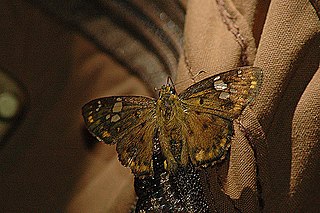
Coladenia is an Oriental genus of spread-winged skippers in the family Hesperiidae. They are found throughout most of Southern, Southeastern, and Eastern Asia. The genus contains the following fifteen species:
